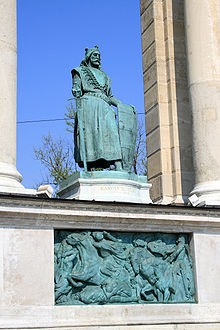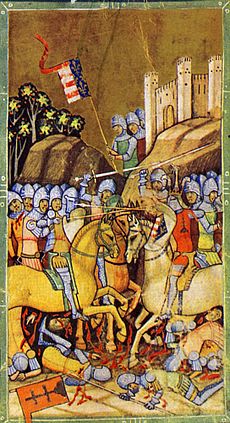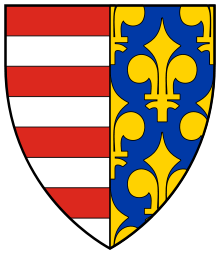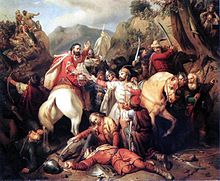- Charles I of Hungary
-
Charles I 
King of Hungary[1] and Croatia Reign 12 July 1312 – 16 July 1342 Predecessor Béla V Successor Louis I Spouse Maria of Bytom
Beatrix of Luxembourg
Elisabeth of PolandIssue Catherine, Duchess of Świdnica
Elisabeth of Hungary (?)
Charles of Hungary
Ladislaus of Hungary
Louis I of Hungary
Andrew, Duke of Calabria
Stephen, Duke of SlavoniaHouse House of Anjou-Hungary Father Charles Martel of Anjou Mother Klementia of Habsburg Born 1288
Naples, Kingdom of NaplesDied 16 July 1342 (aged 54)
Visegrád, Kingdom of HungaryCharles I (1288 – 16 July 1342), also known as Charles Robert (Caroberto), was the first King of Hungary and Croatia (1308–42) of the House of Anjou.[1] He was also descended from the old Hungarian Árpád dynasty. His claim to the throne of Hungary was contested by several pretenders. Nevertheless, although he was only a child when his grandfather, King Charles II of Naples sent him to Hungary in 1300, Charles would strengthen his rule in the kingdom against his opponents and the powerful magnates following a long series of internal struggles. Charles also carried out numerous important political and economical reforms: he established the so called honor system which made the powerful barons dependent of his favour, and he introduced new coins with a consistently high purity of gold. Charles's foreign policy largely stemmed from dynastic alliances. His most successful achievement was the mutual defense union with Poland and Bohemia against the Habsburgs. Charles also endeavoured to enforce his or his descendants' claim to the Kingdom of Naples, but he could achieve only sham results. Nevertheless, he was one of the most successful rulers of the Kingdom of Hungary whose efforts established his successor's achievements.
Contents
Childhood
Charles was born in Naples, southern Italy, the only son of Charles Martel, Prince of Salerno and his wife Clementia, a daughter of King Rudolph I of Germany. His paternal grandmother, Mary, a daughter of King Stephen V of Hungary, declared her claim to Hungary following the death of her brother, King Ladislaus IV of Hungary, but the majority of the country accepted the rule of her distant cousin, King Andrew III. Nevertheless, Mary transferred her claim to Hungary to her eldest son, Charles Martel on 6 January 1292, who was also the heir to the Kingdom of Naples, but he was never able to enforce his claim against King Andrew III and died on 19 August 1295.
After his father's death, the child Charles inherited the claim to Hungary, but his grandfather, King Charles II of Naples appointed his younger son (Charles' paternal uncle), Robert to his heir in the Kingdom of Naples on 13 February 1296. This decree was confirmed by Pope Boniface VIII, the feudal overlord of the Kingdom of Naples, on 27 February 1297, so Charles lost his claim to the Neapolitan throne.
Struggle for Hungary
The weakening of royal authority under Stephen V of Hungary allowed the House of Šubić to regain their former role in Dalmatia.[2] Soon Ladislaus IV of Hungary, recognizing the balance of power in Dalmatia, named Croatian magnate Paul I Šubić of Bribir as Ban of Croatia and Dalmatia.[2] Ladislaus IV died in 1290 leaving no sons, and a civil war between rival candidates pro-Hungarian Andrew III of Hungary, and pro-Croatian Charles Martel of Anjou started.[3] Charles Martel's father Charles II of Naples, awarded all Croatia from Gvozd Mountain (Croatian: Petrova Gora) to the river Neretva mouth hereditary to Paul I Šubić.[3]
In the beginning of 1300, Paul I Šubić accepted Charles' title to the kingdom and invited him to Hungary. His grandfather accepted the invitation and granted Charles a smaller amount of money and sent him to Hungary to enforce his claim against King Andrew III. Charles disembarked in Split in August 1300 and he went to Zagreb where he was accepted as King of Hungary by Ugrin Csák, another influential magnate of the kingdom.
When King Andrew III died on 14 January 1301, Charles' partisans took him to Esztergom where the Archbishop Gregory Bicskei crowned him with an occasional crown because the Holy Crown of Hungary was guarded by his opponents. The majority of the magnates of the kingdom, however, did not accept his rule and proclaimed Wenceslaus, the son of Wenceslaus II of Bohemia king. The young Wenceslaus accepted the election and engaged the daughter of King Andrew III and he was crowned with the Holy Crown of Hungary in Székesfehérvár by Archbishop John of Kalocsa.
After his opponent's coronation, Charles withdrew to Slavonia where his partisans strengthened his rule. In September 1302, he laid siege to Buda, but he could not occupy the capital of the kingdom and had to withdraw to Slavonia again. Pope Boniface VIII confirmed Charles' claim to Hungary on 31 May 1303 and his maternal uncle, King Albert I of Germany also provided him military assistance. In the summer of 1304, King Wenceslaus II of Bohemia arrived to Hungary in order to help his son to strengthen his rule in the kingdom. However, the King of Bohemia had to realise soon that his son's position in Hungary was unstable; therefore he decided to retreat and his son followed him. On hearing his opponents retreat, Charles made an alliance with Duke Rudolph I of Austria and they attacked Bohemia but they could not occupy Kutná Hora and Charles had to retreat to Hungary.
Nevertheless, the majority of the Hungarian magnates did not accept Charles' rule. In August 1305, his opponent, Wenceslaus, who had inherited Bohemia from his father, renounced his claim to Hungary on behalf of Otto III, Duke of Bavaria, who was a grandson of King Béla IV of Hungary. Otto arrived to Hungary soon and he was crowned with the Holy Crown of Hungary in Székesfehérvár by the Bishops of Veszprém and Csanád on 6 December. However, Otto was not able to strengthen his rule, either. In the course of 1306, Charles occupied Esztergom, Spiš Castle, Zvolen and some other fortresses in the northern parts of the kingdom, and in the next year he also occupied Buda.
In June 1307, Duke Otto III visited the powerful Voivode of Transylvania, Ladislaus Kán, but the latter arrested him. On 10 October 1307, the magnates presented at the assembly in Rákos proclaimed Charles king, but the most powerful aristocrats (Máté Csák, Amadé Aba and Ladislaus Kán) ignored him. At the end of the year, Ladislaus Kán set Charles' opponent free and Otto left the country, but the Voivode of Transylvania denied to hand over the Holy Crown of Hungary to Charles, whose legitimacy could be questioned without the coronation with the Holy Crown.
Struggles with the magnates
After Otto's escape, Charles stood alone as claimant to the throne of Hungary, but large parts of his kingdom were under the rule of powerful aristocrats and even his alleged partisans ignored his royal prerogatives. His position slightly strengthened when the legate of Pope Clement V arrived to Hungary in June 1308, who persuaded Máté Csák to recognise Charles' reign on their meeting in the Monastery of Kékes. On 27 November 1308, Máté Csák was also present at the assembly in Pest where Charles was again proclaimed King of Hungary. Following the assembly, the synod of the prelates in Buda confirmed the theory of the inviolability of the king and the bishops also summoned Ladislaus Kán to return the Holy Crown of Hungary to Charles. However, the Voivode of Transylvania denied the request; therefore the Papal legate had a new crown made for Charles and he was crowned with the new crown by Archbishop Tamás of Esztergom on 15 June 1309. Finally, under the threats of the Papal legate, Ladislaus Kán handed over the Holy Crown and Charles was, for the third time, crowned with the Holy Crown on 27 August 1310 by the Archbishop of Esztergom.
In the summer of 1311, Máté Csák laid siege to Charles' capital, Buda, but Charles forced back his attack. Shortly afterwards, the citizens of Košice murdered Amade Aba, who had been one of Charles' main partisans, but Charles took the side of the citizens against Amade Aba's sons; consequently, the latters allied themselves with Máté Csák. Charles laid siege to Máté Csák's castle, Šariš Castle in May 1312, but he was forced to retreat by the troops of the powerful magnate. Then the allied armies of Máté Csák and Amade Aba's sons marched against Košice but Charles defeated them in the Battle of Rozgony on 12 July 1312. After the victory, Charles managed to occupy some castles of Amade Aba's sons in the counties of Abaúj, Torna and Sáros.
In 1314, Charles reoccupied from Austria Devín Castle, taking advantage of the internal conflicts in the Holy Roman Empire, and in the first half of 1315 he managed to reoccupy also the Castle of Visegrád from Máté Csák. At about that time, he married Mary of Bytom, a daughter of Duke Casimir of Bytom.
In the course of May 1316, Charles was struggling against the family Kőszegi, but some magnates of the eastern part of his kingdom, led by Kopasz Borsa, rebelled against him and offered the Holy Crown to King Andrew of Halych, who himself was also a descendant of King Béla IV of Hungary. Charles' troops, however, defeated the rebels and occupied their castles in the counties of Bihar, Szolnok, Borsod and Kolozs. In May 1317, his armies also suppressed the revolt of Amade Aba's sons, and he could occupy the Castle of Komárom from Máté Csák in October.
Charles raised the funds of his military actions by seizing ecclesiastical properties; therefore the prelates made an alliance in 1318 and they demanded that the Estates of the realm be summonded to a general assembly. However, the Estates did not raised objections against the king's policies at their assembly in July. During the year, his troops occupied several fortresses of the deceased Ladislaus Kán's sons in Transylvania.
After his first wife's death, the widowed Charles married Beatrix of Luxemburg, daughter of Henry VII, Holy Roman Emperor and sister of King John I of Bohemia, probably in September 1318. In the summer of 1319, he led his armies against King Stefan Uroš II Milutin of Serbia, who had occupied the southern part of the Kingdom of Hungary, and defeated the Serbian troops near Macsó. After his victory, Charles reoccupied Beograd and also the territory of the Banate of Macsó. At that time, Charles began to reorganise the financial basis of the royal power by declaring that it is only the king who is entitled to open new custom-houses in the kingdom.
His second wife, Beatrix and her only child died at its birth on 11 October 1319. Charles, having widowed for the second time, married Elisabeth, a daughter of King Wladislaus I of Poland on 6 July 1320.
The death of Máté Csák on 21 March 1321, the most powerful aristocrat in the kingdom, resulted in the disintegration of his provinces and Charles' troops could occupy all the fortresses of the deceased baron till the end of the year. In January 1322, the towns in Dalmatia rebelled against the rule of Ban Mladen II Šubić of Bribir, whose family had been among Charles' first supporters. Charles, taking advantage of the situation, went to Dalmatia and arrested the powerful Ban and enstrengthened his power in Croatia and Dalmatia.
The restoration of the royal power
Charles carried out numerous important political and economical reforms. In the beginning of 1323, he renounced the royal prerogative of undermining the currency and introduced a new tax (lucrum camaræ) in order to ensure the permanency of the royal revenues. In the same year, Charles transferred his seat to Visegrád from Timişoara.
Charles established the so called "honor system": instead of large donations, faithful servants of the king were given an office (in Latin honor), thus they became the keeper of royal property (including castles) in the counties and the representative of the king. However, these offices were not given for eternity, because the king could deprive his people of their office any time. Most powerful "honors" often rotated among the members of aristocracy.
New economic policy
Charles introduced a new economic policy based on regales or royalties.
- Urbura (=bányabér) was the tax of mines (1/10 of gold and 1/8 of silver)
The landowners – to avoid taxation – kept their mines in secret in 1327 Charles Robert, in order to inspire the landowners open new mines, ordered to gave back the 1/3 of the tax to them.
- Minting money
Only the king was allowed to mint money, who wanted to make an acceptable currency, which wouldn’t devaluate (no income from exchange fee, but it supported external trading)
- Tricesima (Hungarian: harmincadvám)
It was a customs system. The tariff was 1/30 of all foreign commercial affairs.
- Gate tax
Was mainly collected from the peasantry after every gate, where a cart could go through.
- Census (tax of townships and royal landholdings)
also levied tax on the church (1/3 of the papal income)
Charles successfully curbed inflation, introducing new coins with a constantly high purity of gold. Florins minted, from 1325, in a newly established mint in Kremnica became soon the popular international means of payment throughout Europe. The reform of the currency and of the whole fiscal system greatly contributed to enrich the treasury.
Foreign policy
Charles's foreign policy largely stemmed from dynastic alliances and he also endeavoured to strengthen his rule over the neighbouring territories that had accepted the supremacy of the Kings of Hungary in the course of the 13th century.
His most successful achievement was the mutual defense union with Poland and Bohemia against the Habsburgs, accomplished by the convention of Trenčín in 1335, confirmed the same year at the brilliant two-month congress of Visegrád. Not only did all the princes of Central Europe compose their differences and enjoy splendid entertainment during the months of October and November: the immediate result of the congress was a combined attack by the Hungarians and Poles upon Louis IV, Holy Roman Emperor and his ally the Habsburg Duke Albert II of Austria, which resulted in favor of Charles in 1337.
Charles's desire to unite the kingdoms of Hungary and Naples under his eldest son Louis I was dashed by Venice and by the Pope, who both feared Hungary might become the dominant Adriatic power. Nevertheless he was more than compensated for this disappointment by his compact in 1339 with his ally and brother-in-law, Casimir III of Poland, whereby it was agreed that Louis should succeed to the Polish throne on the death of the childless Casimir. Finally his younger son, Andrew, Duke of Calabria was promised the crown of Naples.
Deterioration of the southern frontier
The Árpád kings had succeeded in encircling their whole southern frontier with six military colonies or banates, comprising, roughly speaking, Little Wallachia (southern part of present-day Romania) and the northern parts of present-day Bulgaria, Serbia and Bosnia, September 2010. Charles redistributed these territories and proselytized the residents of the region to consolidate his reign.
Although he managed to expand his kingdom, the adverse effect was converting most of the old banates into semi-independent and violently anti-Hungarian principalities. The predominant religion of the area was Greek-Orthodox, and forceful proselytization to Catholicism provoked rebellion[dubious ][citation needed]. Natural dynastic competition with the Orthodox Serbian and Bulgarian tsars and the emergence of a new Wallachia also contributed to the uprising.
Prior to 1320, Western Wallachia (Oltenia) was regarded by the Hungarians as part of the banate of Szörény (Severin). When the Wallachian ruler, Basarab I showed signs of disobedience, Charles lead his army into Wallachia, though poor supplies caused him to return after occupying several towns. On his return 9 November 1330, the Hungarian army got lost between the mountains. The Wallachians and Hungarians signed a peace treaty and Basarab vowed to show them out of the mountain pass, but in fact the Wallachians trapped the Hungarians in an ambush at Posada. In the Battle of Posada, King Charles barely escaped, by exchanging clothes with one of his knights. This incident marked the beginning of Wallachia as an independent voivodeship.
Because of its large financial power, the Kingdom of Hungary quickly rebuilt its army and found itself in conflict with the Holy Roman Empire in 1337. However, the Hungarian King maintained a de-jure suzeranity over Wallachia until the diplomatic disputes had been solved.[4]
Unknown to Charles, the Ottoman Turks had already secured Asia Minor under the sultans Osman I and Orhan I and planned to invade south-eastern Europe to consolidate their realm. The south-eastern European sovereignties were keener on securing their regimes than on co-ordinating their defences. Their diversity helped the Ottomans expand their dominion into the region.
Charles Robert died at Visegrád, Hungary[1] in 1342.
Marriages and children
Mistress
Charles had a mistress named Elisabeth Csák, daughter of George Csák. They were parents to Coloman of Hungary, Bishop of Győr (1318 - 1375/1376).[5]
First marriage
Charles married three times.[5] His first wife was Maria of Bytom, a member of the Piast dynasty.[6] She was a daughter of Casimir of Bytom and his wife Helena.
Charles and Maria possibly had two daughters:
- Katharine of Hungary, married Henry II of Świdnica and was mother of Anne of Świdnica; Anna was the third wife of Charles IV, Holy Roman Emperor and mother of Wenceslaus, King of the Romans.
- Elisabeth Anjou of Hungary (d.1367), married Boleslaw of Opole.
Some believe that Katherine and Elisabeth were daughters of Elisabeth of Poland, Charles's third wife.
Second marriage
In 1318, Charles married his second wife Beatrix of Luxembourg. She was a daughter of Henry VII, Holy Roman Emperor and Margaret of Brabant. Beatrix was a younger sister of both John of Bohemia and Marie de Luxembourg, Queen of France. In November 1319, Beatrix died after giving birth to a stillborn child.[7]
Third marriage
On 6 July 1320, Charles married his third wife Elisabeth of Poland. She was a daughter of Władysław I the Elbow-high and Hedwig of Kalisz.[8] They had five sons:
- Charles (1321).
- Ladislaus (Belgrade, 1 November 1324 – 24 February 1329).
- Louis I of Hungary (1326–1382).
- Andrew, Duke of Calabria (1327–1345).
- Stephen, Duke of Slavonia (1332–1354).
It is possible that Charles' two daughters Katherine and Elisabeth were daughters of Elisabeth of Poland, rather than Maria of Bytom.
Ancestors
Ancestors of Charles I of Hungary 16. Louis VIII of France 8. Charles I of Naples 17. Blanche of Castile 4. Charles II of Naples 18. Raymond Berengar IV of Provance 9. Beatrice of Provence 19. Beatrice of Savoy 2. Prince Charles Martel of Salerno 20. Bela IV of Hungary 10. Stephen V of Hungary 21. Maria Laskarina 5. Mária of Hungary 22. Köten 11. Elizabeth the Cuman 23. ? 1. Charles I of Hungary 24. Rudolph II, Count of Habsburg 12. Albert IV, Count of Habsburg 25. Agnes of Staufen 6. Rudolph I of Germany 26. Ulrich of Kiburg 13. Heilwig of Kiburg 27. Anna of Zähringen 3. Klementia of Habsburg 28. Burckhard IV of Hohenburg 14. Burckhard V of Hohenburg 29. ? 7. Gertrude of Hohenburg 30. Rudolph of Tüblingen 15. Mechtild of Tübingen 31. ? Titles
King of Hungary, Dalmatia, Rama, Croatia, Cumania, Bulgaria, Galicia and Lodomeria
References
- ^ a b c "Charles I". Encyclopædia Britannica. http://www.britannica.com/eb/article-9022561/Charles-I#90690.hook. Retrieved 2008-05-02.
- ^ a b Fine (The Late Medieval Balkans – 1994), p. 206.
- ^ a b Fine (The Late Medieval Balkans – 1994), pp. 207–208.
- ^ Djuvara, pp.190–195 – "...Basarab l-ar fi trimis prin 1343 sau 1344, pe fiul său Alexandru, asociat la domnie, pentru a restabili legăturile cu regele Ungariei, ...".
- ^ a b Profile of Charles in "Medieval Lands" by Charles Cawley
- ^ Profile of Maria in "Medieval Lands" by Charles Cawley
- ^ Profile of Beatrix in "Medieval Lands" by Charles Cawley
- ^ Profile of Władysław in "Medieval Lands" by Charles Cawley
 This article incorporates text from a publication now in the public domain: Chisholm, Hugh, ed (1911). Encyclopædia Britannica (11th ed.). Cambridge University Press.
This article incorporates text from a publication now in the public domain: Chisholm, Hugh, ed (1911). Encyclopædia Britannica (11th ed.). Cambridge University Press.Sources
- Fine, John Van Antwerp (1994). The Late Medieval Balkans: A Critical Survey from the Late Twelfth Century to the Ottoman Conquest. Michigan: The University of Michigan Press. ISBN 0472082604, 0472100793.
External links
- His picture on the Hungarian 200 forint banknote
- (French) Armorial of the House Anjou-Sicily
- (French) House of Anjou-Sicily
- His profile in "Medieval Lands" by Charles Cawley
Charles I of HungaryCadet branch of the Capetian dynastyBorn: 1288 Died: 16 July 1342Regnal titles Preceded by
Béla VKing of Hungary
1308–1342Succeeded by
Louis ITitles in pretence Preceded by
Béla V— TITULAR —
King of Croatia
1307–1342Succeeded by
Louis IMonarchs of Hungary - Stephen I (1000–1038)
- Peter (1038–1041; 1044–1046)
- Samuel (1041–1044)
- Andrew I (1046–1060)
- Béla I (1060–1063)
- Solomon (1063–1074)
- Géza I (1074–1077)
- Ladislaus I (1077–1095)
- Coloman (1095–1116)
- Stephen II (1116–1131)
- Béla II (1131–1141)
- Géza II (1141–1162)
- Stephen III (1162–1172)
- Ladislaus II (1162–1163)
- Stephen IV (1163)
- Béla III (1172–1196)
- Emeric (1196–1204)
- Ladislaus III (1204–1205)
- Andrew II (1205–1235)
- Béla IV (1235–1270)
- Stephen V (1270–1272)
- Ladislaus IV (1272–1290)
- Andrew III (1290–1301)
- Ladislaus V (1301-1305)
- Béla V (1305-1308)
- Charles I (1310–1342)
- Louis I (1342–1382)
- Mary (1382–1385; 1386–1395)
- Charles II (1385–1386)
- Sigismund (1387–1437)
- Albert (1437–1439)
- Vladislaus I (1440–1444)
- Ladislaus V (1444–1457)
- Matthias I (1458–1490)
- Vladislaus II (1490–1516)
- Louis II (1516–1526)
- John I (1526–1540)
- John II (1540–1570)
- Ferdinand I (1526–1564)
- Maximilian (1564–1576)
- Rudolph (1576–1608)
- Matthias II (1608–1619)
- Ferdinand II (1619–1637)
- Ferdinand III (1637–1657)
- Ferdinand IV (1647–1654)
- Leopold I (1657–1705)
- Joseph I (1705–1711)
- Charles III (1711–1740)
- Maria Theresa (1740–1780)
- Joseph II (1780–1790)
- Leopold II (1790–1792)
- Francis (1792–1830)
- Ferdinand V (1830–1848)
- Francis Joseph (1848–1916)
- Charles IV (1916–1918)
Monarchs of Croatia House of Trpimirović (Croatia) Tomislav (910–928) · Trpimir II (928–935) · Krešimir I (935–945) · Miroslav (945–949) · Michael Krešimir II (949–969) · Stephen Držislav (969–997) · Svetoslav Suronja (997–1000) · Krešimir III (1000– c. 1030) with Gojslav (1000–c. 1020) · Stephen I (c. 1030–1058) · Peter Krešimir IV (1058–1074) · Demetrius Zvonimir (1075–1089) · Stephen II (1089–1091)House of Árpád (Hungary) Ladislaus I (1091–1093)House of Svačić (Croatia) Petar Svačić (1093–1097)House of Árpád (Hungary) Coloman (1097–1116) • Stephen III (1116–1131) • Béla I (1131–1141) • Géza (1141–1162) • Stephen IV (1162–1172) • Ladislaus I (1162–1163) • Stephen V (1163) • Stephen IV (1163–1172) • Béla II (1172–1196) • Emeric (1196–1204) • Ladislaus II (1204–1205) • Andrew I (1205–1235) • Béla III (1235–1270) • Stephen VI (1270–1272) • Ladislaus III (1272–1290)House of Anjou (Naples) Charles Martel (1290–1295)House of Árpád (Hungary) Andrew II (1295–1301)House of Anjou (Naples) Charles I Robert (1301–1342) • Louis I (1342–1382) • Mary (1382–1385) • Charles II (1385–1386) • Mary (1386–1395)House of Luxemburg (Bohemia) Sigismund (1387–1437)House of Savoy (Savoy) Tomislav II (1941–1943)Categories:- 1288 births
- 1342 deaths
- 13th-century Hungarian people
- 14th-century Hungarian people
- Roman Catholic monarchs
- House of Anjou-Hungary
- Hungarian monarchs
- Hungarian people of Italian descent
- People from Naples
- Burials at Székesfehérvár Cathedral
Wikimedia Foundation. 2010.




